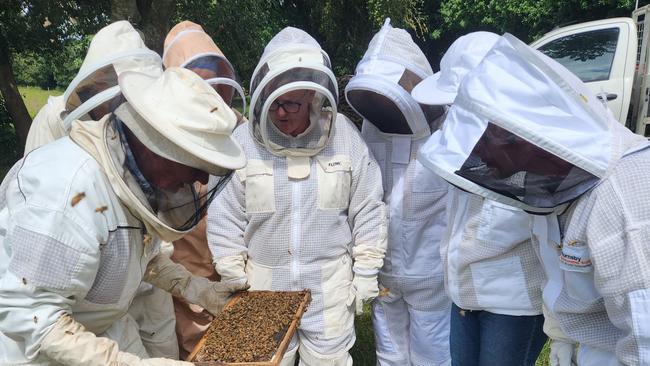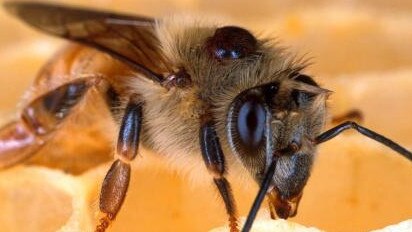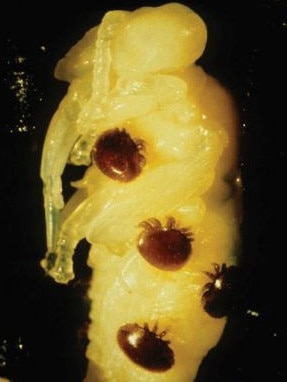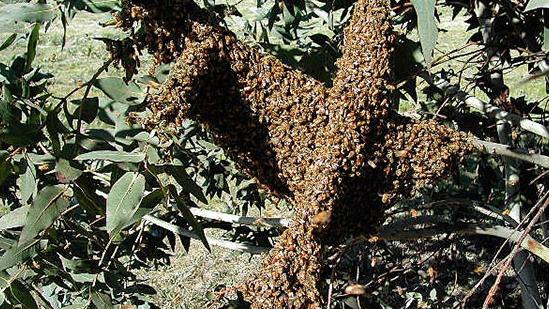Bee all, end all: $100m Transition to Management Plan to combat Varroa mite as pest hits Aussie hives
A northern NSW beekeeper worries the killer Varroa mite has been in Australia longer and spread further than previously thought. It comes as a huge amount of cash has been pledged to fight the incursion.

Regional News
Don't miss out on the headlines from Regional News. Followed categories will be added to My News.
A year-long biosecurity control order issued to help combat parasitic Varroa mites targeting NSW bees has been backed by a $100 million joint government and industry investment.
It comes as Far North Coast Beekeepers president Chris Shands said he believes the mite has been in the country longer and spread further than previously thought.
Australia was the largest honey bee producing country to be free of varroa mites (Varroa destructor, or V. jacobsoni) – but biosecurity officers found the tiny red-brown pests at Newcastle Port in 2022.
The mites present the “greatest biological threat to Australia’s honey bee and pollination-dependent plant industries”, according to CSIRO scientist Dr John Roberts.

Areas reporting the bee-killing mite include forests surrounding Nana Glen, Sherwood, Woolgoolga, and Wooli.
Greater Sydney and Newcastle areas along with greater Kempsey areas have been declared management zones while the remainder of the state is classed as under suppression.
Varroa mites cannot attack Australian native bees directly, research shows, because they are biologically different from European honey bees.
Plans were last year scrapped to eradicate the bug and the federal government’s National Management Group has endorsed a Transition to Management Plan.
Beekeepers will be trained on preventing infestations by several dozen industry officers.
The response to the mite after the Newcastle discovery has been one of the biggest biosecurity responses in the nation’s history – but it’s not enough.

NSW Department of Primary Industries (NSW DPI) set up the zones to combat the outbreak.
Restrictions on moving bees, beehives and bee keeping equipment in and out of these zones is in place and beekeepers must report hive details.
NSW Agriculture Minister Tara Moriarty said Australia was the last major honey producing country in the world to be hit by the mite.
“We are using international experience and science in understanding how best to prepare beekeepers and the beekeeping and pollination reliant industries,” she said.
Since the mite was deemed “no longer eradicable from Australia”, Ms Moriarty said training modules have been made available and industry events and workshops have been in the works.
Varroa development officers will work with beekeepers and volunteers and pollination industry coordinator will also be employed.
“This will be critical for smaller industries who have relied on wild bees for pollination and never engaged with pollination service providers,” Ms Moriarty said.

Mr Shands told The Northern Star: “Our group had a meeting last Sunday that talked specifically about Verroa mite and what we need to do.”
“So we’ve been trying to prepare our club members for the last 12 months on how to identify Varroa mite in their hives,” he said.
Mr Shands said using a specific alcohol wash was recognised as the best way to spot the mites.
“They’re washed, stirred up in the metho for eight to ten minutes and any Verroa mite that’s present will be washed off the bees,” he said.
“When you pour out the sample of liquid you’ll see these little spots that are sort of a reddish-pinkish colour and they’re not much bigger than the tip of a pen.”

He said beekeepers moving hives to help pollinate macadamias and avocados in the Northern Rivers could unwittingly be spreading the pests, and feral bees could present a problem.
“ … we can in some ways try to control Verroa in our managed hives, but we’ve got no way of doing that in wild hives,” he said.
“The Verroa mite will build up in those wild hives and kill off a lot of bees. Then the surviving bees will often find a managed hive and proportionately infect more bees than if the feral hives weren’t around.”
Mr Shands said the mite takes time to “build up” in a hive and regular monitoring and strategic use of chemicals can help.
He said it was important for keepers to band together to combat the mite’s spread and impact.
Verroa mite is a relatively “new thing” in the nation – but Mr Shands said pests always present challenges and he urged beekeepers to continue to take part.




